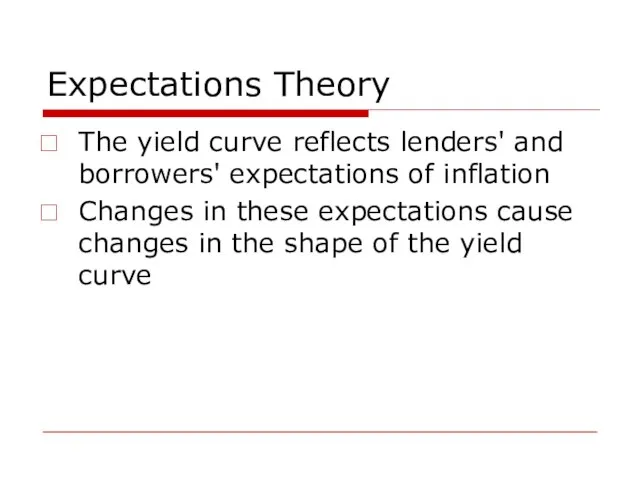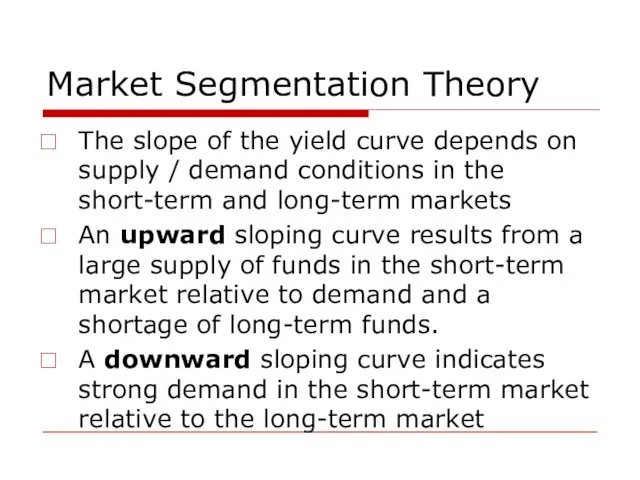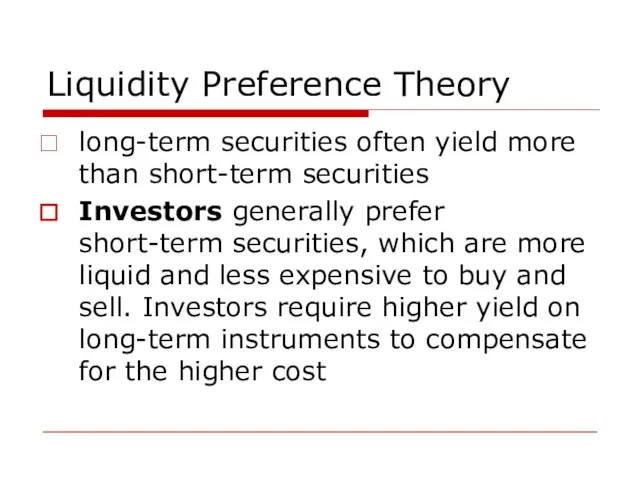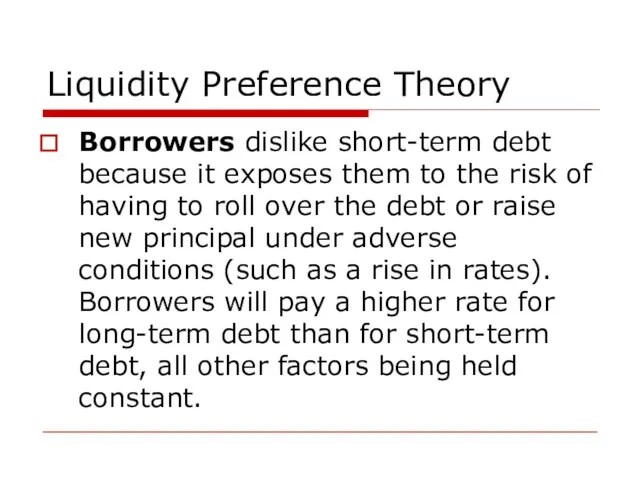Слайд 2FINANCIAL MARKETS AND
INTEREST RATES

Слайд 3Market Players
An investor / lender is an individual, company, government, or any

entity that owns more funds than it can use.
An issuer / borrower is an entity that has a need for capital.
Brokers and dealers are financial intermediaries, who purchase securities from issuers and sell them to investors
Слайд 4Securities
Debt security or bond – promises periodic payments of interest and/or principal

from a claim on the issuer's earnings
Equity or stock – promises a share in the ownership and profits of the issuer
Слайд 5Types of Financial Markets
Money markets trade short-term, marketable, liquid, low-risk debt securities

- "cash equivalents“
Capital markets trade in longer-term, more risky securities:
bond (or debt) markets,
equity markets,
derivative markets
Слайд 6INTEREST RATES
The stated or offered rate of
interest (r) reflects three factors:
Pure

rate of interest (r*)
Premium that reflects expected inflation (IP)
Premium for risk (RP)
r = r* + IP + RP
Слайд 7Pure Interest Rate
the rate for a risk-free security when no inflation is

expected
constantly changes over time, depending on economic conditions
Слайд 8Inflation
Investors build in an inflation premium to compensate for this loss of

value
the inflation premium is not constant; it is always changing based on investors' expectations of the future level of inflation
Слайд 9Risk
Counterparty (default) risk is the chance that the borrower will not be

able to pay the interest or pay off the principal of a loan.
Ratings companies identify and classify the creditworthiness of corporations and governments to determine how large the risk premium should be (AAA – CCC)
Слайд 10Risk
Liquidity risk – possible losses if there is no opportunity to buy

or to sell assets at the proposed volume for the proposed price due to bad market conditions
Слайд 11Risk
Interest rate risk - possible changes of asset value due to changes

of the interest rate:
As interest rates increase, bond prices decrease.
As interest rates decrease, bond prices increase.
Слайд 12Risk
Currency risk – possible changes of the assets value due to changes

of the currency exchange rate.
Operational risk – possible losses due to possible technical mistakes.
Business-event risk – possible losses due to force-mageure events, changes in legislation, etc.
Слайд 13Normal Yield Curve Theories
upward sloping yield curve is considered normal:
expectations theory,
the

market segmentation theory,
the liquidity preference theory
Слайд 14Expectations Theory
The yield curve reflects lenders' and borrowers' expectations of inflation
Changes in

these expectations cause changes in the shape of the yield curve
Слайд 15Market Segmentation Theory
The slope of the yield curve depends on supply /

demand conditions in the short-term and long-term markets
An upward sloping curve results from a large supply of funds in the short-term market relative to demand and a shortage of long-term funds.
A downward sloping curve indicates strong demand in the short-term market relative to the long-term market
Слайд 16Liquidity Preference Theory
long-term securities often yield more than short-term securities
Investors generally prefer

short-term securities, which are more liquid and less expensive to buy and sell. Investors require higher yield on long-term instruments to compensate for the higher cost
Слайд 17Liquidity Preference Theory
Borrowers dislike short-term debt because it exposes them to the

risk of having to roll over the debt or raise new principal under adverse conditions (such as a rise in rates). Borrowers will pay a higher rate for long-term debt than for short-term debt, all other factors being held constant.
















 Об образовании в Российской Федерации
Об образовании в Российской Федерации Как подготовить свой проект?
Как подготовить свой проект? История космических побед
История космических побед Досрочное отчисление из школы. Федеральный закона Об образовании в РФ
Досрочное отчисление из школы. Федеральный закона Об образовании в РФ Доклад по информатике Уч-ка 8 класса "Б" Блинова Юрия
Доклад по информатике Уч-ка 8 класса "Б" Блинова Юрия Аборигены Австралии
Аборигены Австралии ВЫХОДИ В ИНТЕРНЕТ!
ВЫХОДИ В ИНТЕРНЕТ! Project 2
Project 2 Василий Алексеевич ВАТАГИН (1883/1884 - 1969)
Василий Алексеевич ВАТАГИН (1883/1884 - 1969) Финансовые ресурсы торговой организации ООО Профильком: состав, структура и методы прогнозирования
Финансовые ресурсы торговой организации ООО Профильком: состав, структура и методы прогнозирования Принцип Гюйгенса. Принцип Ферма. Законы отражения света
Принцип Гюйгенса. Принцип Ферма. Законы отражения света Сюрреализм
Сюрреализм Педагогика как наука …или искусство?… и (!) искусство
Педагогика как наука …или искусство?… и (!) искусство Komparatiivi ja superlatiivi
Komparatiivi ja superlatiivi Каталог Идель (Халяль) 2021 (1)
Каталог Идель (Халяль) 2021 (1) Сплавы
Сплавы Алгоритмы. Определение, виды и свойства.
Алгоритмы. Определение, виды и свойства. Геометрия в моде
Геометрия в моде Лавсан
Лавсан Город площадей и театров: Площадь Искусств
Город площадей и театров: Площадь Искусств Психоаналитические причины преступности
Психоаналитические причины преступности Православные праздники
Православные праздники Презентация на тему Жидкие кристаллы
Презентация на тему Жидкие кристаллы  Абсолютизм в Западной Европе. Тридцатилетняя война 1618-1648года
Абсолютизм в Западной Европе. Тридцатилетняя война 1618-1648года Сводная таблица по приемным кампаниям 2016-2019 гг
Сводная таблица по приемным кампаниям 2016-2019 гг План муниципальной площадки по образовательной области Физическое развития для инструкторов ФИЗО г. Чебоксары
План муниципальной площадки по образовательной области Физическое развития для инструкторов ФИЗО г. Чебоксары e5c514b9d0e1405ebf6e3dc143fce7f1 (3)
e5c514b9d0e1405ebf6e3dc143fce7f1 (3) Зачет с оценкой. Управление персоналом
Зачет с оценкой. Управление персоналом